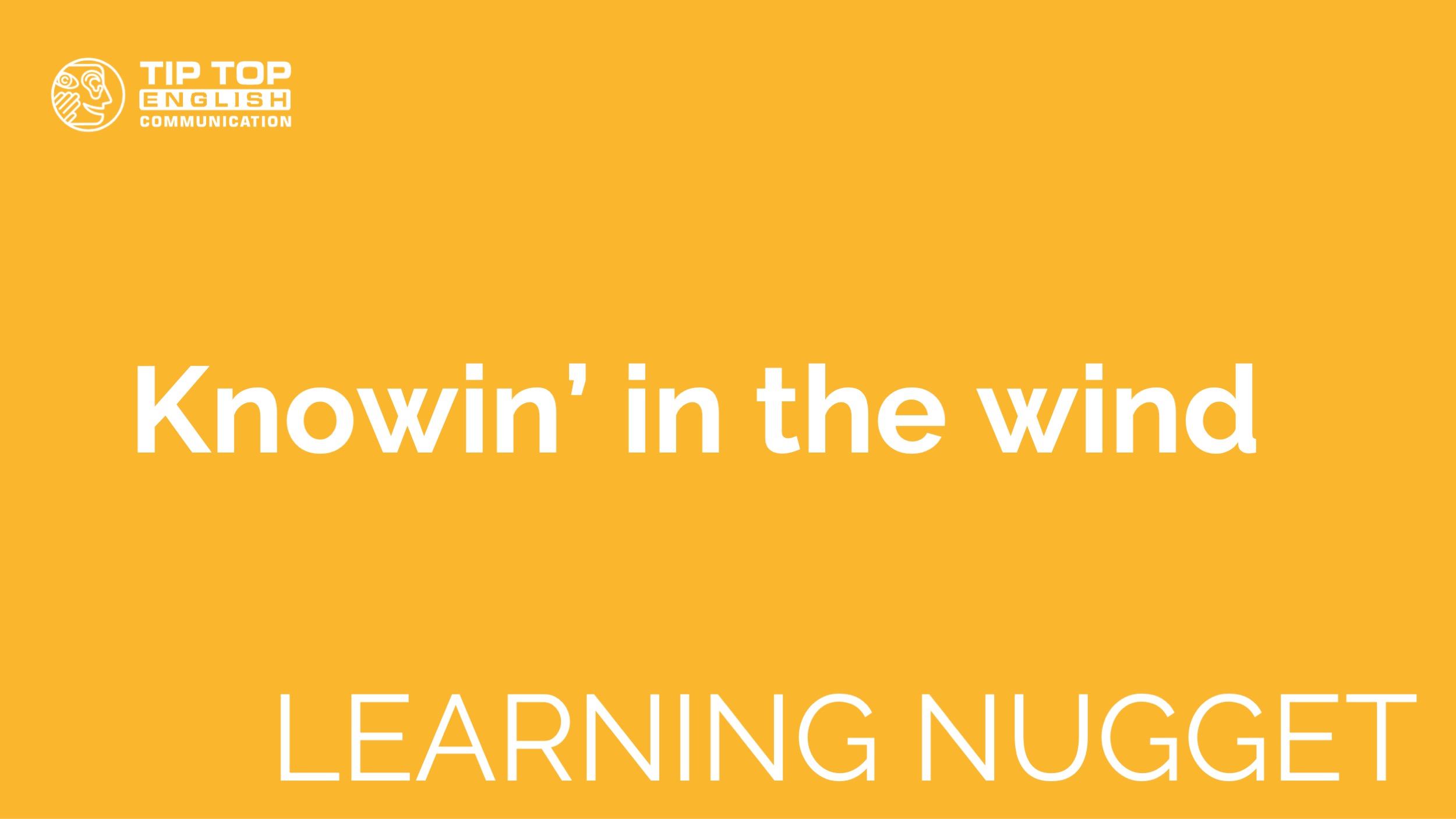Knowin’ in the wind
Last weekend you may have found yourself doing something unexpected, like snatching a lawn chair out of the air or making sure your chihuahua wasn’t blown up into the clouds. This was because as storm Eberhard blew its way across Germany, it brought winds that topped the 100 km/h mark in some places and wreaked havoc on highways, public transport, and personal property.
Though it’s calmer than last weekend, it’s still plenty gusty out there. So when thinking about topics for this month’s Learning Nugget, taking some time to learn a little bit about wind seemed like the perfect choice. However, this isn’t going to be a boring science lesson. Yes, we fill you in on the basic facts about how wind is created, but we also take a look at the highlights of wind energy’s over 5,000-year-old history among humankind as well as some fun English idioms that deal with the wind.
What makes wind?
Wind is a movement of air from an area of high pressure to an area of low pressure.
High pressure is created when a surface is cool. Cold air is heavier, so it stays near the ground, increasing the pressure near the surface of the cold area. As you might expect, warmth creates low pressure because warm air is lighter and rises. Wind occurs because places on Earth don’t heat evenly and air is continuously moving from colder to warmer surfaces.
Probably the easiest way to understand this is to think about land near the sea or a lake. Land heats faster than water, so by the time it’s afternoon on a sunny day, land is a place with very low pressure compared to the cooler water, and air moves quickly from water to land. That’s why it’s so often windier in the afternoon when you’re near water. At night, the land often cools down while the water retains its heat, and the wind changes direction. Air begins rushing from the cooler, higher pressure land to the warmer, lower pressure water.
Of course, there are many other factors that determine where wind will be and how strong it is but underlying it all is the constant migration of air from high pressure to low pressure areas.
The history of wind energy
Whether we understood where it came from or not, humans have been using wind energy to accomplish a huge range of tasks for thousands of years. Some of these uses have been briefly summed up by the U.S. Energy Information Administration:
People used wind energy to propel boats along the Nile River as early as 5,000 BC. By 200 BC, simple wind-powered water pumps were used in China, and windmills with woven-reed blades were grinding grain in Persia and the Middle East.
And those windmills in Persia (modern-day Iran) and the Middle East would inspire Europeans to build their own. The most famous European example is in the Netherlands, where windmills were used not only for processing grains, but also other goods, like pigments for dyes.
Today, wind energy is most closely connected with its ability to create electricity and is growing in popularity as nations seek renewable, clean energy sources. But even this use of wind has a longer history than you might expect.
In 1887 a professor in Scotland by the name of Andrew Blyth built and used one of the first electricity-generating windmills to light his cottage. In the same time period, an important figure in the early days of US electricity named James Brush had a giant windmill built to power his Ohio home.
Over time, the design of electricity-generating windmills has been made more efficient, allowing them to power not just individual houses, but become an important energy generator for whole countries. A huge step in this process was Paul la Cour’s discovery in the early 20th century that if a turbine had fewer blades, it could spin more quickly and produce more energy than turbines with many blades.
In fact, some of the first turbines designed for major power production in Denmark had only two blades. Though the design generated a very fast movement of the blades, it also was unstable, causing turbines to wobble and quickly fall into disrepair and be less efficient. Today, three-bladed turbines are the norm because they are stable but have few enough propellers to produce large amounts of energy.
However, a company called Vortex Bladeless in Spain is designing a bladeless turbine that is receiving lots of funding and attention. It could be that this invention will soon make the rotating propellers that have become fixtures along highways throughout Europe disappear.
Because of their reputation for high use of fossil fuels, it may surprise you that the top producers of wind energy in the world are China and the USA (less surprisingly, Germany is #3). Recently, China produced 12.2 gigawatts of power over a year through wind. One gigawatt is enough to power roughly 700,000 homes.
That means China produced enough energy through wind to supply around 8.5 million homes with electricity, or roughly enough for both the Netherlands and New Zealand combined.
Wind idioms
Clearly, wind has been a constant for humanity, so it’s no surprise that it’s used in many idiomatic expressions in various languages. English is no different, and here are three interesting English idioms that mention wind and their meanings:
Here are a few examples:
When you spit into a strong wind, the spit doesn’t go anywhere or, worse, hits you in the face as it blows back. That’s exactly the meaning of this idiom. If you do something pointless or something that is only going to cause needless difficulties for you, you’re spitting into the wind.
Example: Trying to shovel snow off your driveway during a blizzard is just spitting into the wind.
Three sheets to the wind
For this one, we’re back to windmills. Dutch windmills traditionally have four blades, and millers would attach sails or “sheets” to the blades of the windmill to catch wind. The number always had to be even (two or four), or the windmill would become unbalanced. If a windmill had only three sheets, it would shake and wobble looking just like…a very drunk person. So, someone who is “three sheets to the wind” has had quite a bit to drink and isn’t walking in straight lines anymore.
Example: On his birthday, Paul drank three bottles of wine by himself and he was three sheets to the wind.
Knock the wind out of someone’s sails
When a ship has wind in its sails, it is moving quickly to its destination, making everyone aboard happy that they’ll see land again as soon as possible. On the other hand, when there’s no wind and a ship isn’t moving, the mood is the exact opposite. So, when you “knock the wind out of someone’s sails,” you’re making someone who is feeling great suddenly feel bad.
Example: The soccer team thought they had scored a goal and won the game, but the wind was knocked out of their sails when they saw that the referee had called their player offsides.
Before we turn into blowhards…
We could keep talking about wind for pages and pages, but we’re going to stop here for now. And even though we don’t want to see winds as destructive as those that came with Eberhard again any time soon, we hope you’ve enjoyed learning about how wind is made and some of its functions in human society and the English language.
Keep a lookout for next month’s TIP TOP Learning Nugget to continue expanding your knowledge of the world around you and, most importantly, to have some fun facts to impress your friends and family with.
Vocabulary
unexpected – unerwartet
to snatch – schnell nach etwas greifen
lawn chair – Gartenstuhl
chihuahua – kleiner mexikanischer Hund
making sure – sichergehen
blown up – gesprengt, aufgeblasen
blew its way across – der Wind blies/bahnte sich seinen Weg durch…
wreaked havoc – verheerenden Schaden angerichtet
plenty gusty – ziemlich stürmisch
fill sb. in on – jemanden einweihen, auf den neusten Stand bringen
humankind – Menschheit
area of high pressure, low pressure area – Hochdruckgebiet, Tiefdruckgebiet
surface – Oberfläche
heavier (heavy, heavier, heaviest) – schwer
stay near the ground – bleibt nahe am Boden
you might expect – dürften Sie erwarten
wind occurs – Wind tritt auf
heat evenly – gleichmäßig erhitzen
to retain – behalten, hier: speichern
determine – bestimmen, festlegen
underlying – zugrunde liegen
constant migration of – stetige Abwanderung
accomplish a huge range of tasks – eine Fülle von Aufgaben erfüllen
sum up – zusammenfassen
propel boats – Boote antreiben
Nile River – Nil
wind-powered – windbetriebene
water pumps – Wasserpumpen
woven-reed blades – aus Reet gewebte Flügelblätter
to grind grain – Korn mahlen
process grain – Korn verarbeiten
pigments for dyes – Pigmente zum Färben
growing in popularity – wächst an Popularität
renewable – erneuerbar
electricity-generating – Strom erzeugend
to light – beleuchten
over time … has been made – im Laufe der Zeit wurden… (immer mir present perfect benutzt)
discovery – Entdeckung
turbine – Turbine
fewer blades – weniger Flügelblätter
spin more quickly – sich schneller drehen
though – obwohl
unstable – instabil
to wobble – wackeln, flattern
fall into disrepair – verfallen, verwahrlosen
bladeless – flügellos
to receive funding – finanzielle Förderung erhalten
invention – Erfindung
become fixtures along – Vorrichtungen werden entlang…
independent – unabhängig
fossil fuels – fossile Brennstoffe
to power – antreiben, mit Energie versorgen
to supply homes – Haushalte versorgen
wind idioms – idiomatische Redewendungen mit Wind
spit – spucken
do to something pointless – etwas Sinnloses machen
needless difficulties – überflüssige Schwierigkeiten
shovel snow off – Schnee wegschaufeln
destination – Ziel
aboard – an Board
referee – Schiedsrichter
call a player offsides – Abseits pfeifenturn into blowhards – Wichtigtuer werdendestructive – zerstören
most importantly – am Wichtigsten
impress sb. – jemanden beeindrucken
Excite Your Senses

On our YouTube channel, you can follow along as a native speaker reads this month’s Learning Nugget accompanied by music and pictures.
